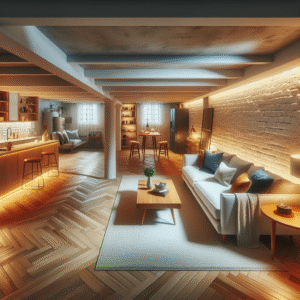A home renovation is an exciting opportunity to transform your living space, whether you’re upgrading a kitchen, adding a new room, or refreshing outdated décor. However, without careful planning, renovations can become overwhelming and costly. To ensure your project is a success, you need to follow a structured approach that keeps everything on track, from budgeting and design to hiring professionals and managing timelines.
In this step-by-step guide, we’ll take you through the entire home renovation process, offering tips and insights that will help you make informed decisions, avoid common pitfalls, and achieve the results you’re dreaming of.
1. Define Your Renovation Goals
Before you start any renovation, it’s important to have a clear understanding of what you want to achieve. This initial step helps guide the rest of the process and ensures that your goals align with your budget and timeframe. Ask yourself the following questions:
- What’s the main purpose of your renovation? Are you renovating to improve functionality, increase home value, or enhance aesthetics?
- Which areas of the home are you focusing on? Are you planning a full home renovation or targeting specific rooms, such as the kitchen, bathroom, or living area?
- Do you have specific design or style preferences? Think about the overall look and feel you want for your space, including color schemes, materials, and architectural features.
Having a clear vision will help you make decisions more efficiently as you move forward with your renovation.
2. Set a Realistic Budget
Budgeting is a critical step in the planning process. Renovation costs can add up quickly, so it’s essential to set a realistic budget that includes both expected and unexpected expenses. Here are some tips for creating a budget that works for your renovation:
Determine Your Total Budget
Start by assessing how much you’re willing to spend on the entire renovation. Be honest about your financial situation and consider how you’ll fund the project. Will you be paying out of pocket, taking out a loan, or using home equity? Once you’ve determined your total budget, you can start allocating funds to different areas of the project.
Break Down Costs by Category
Divide your budget into categories based on different aspects of the renovation. Common categories include:
- Labor and Contractor Fees: This includes the cost of hiring professionals such as contractors, electricians, plumbers, and carpenters.
- Materials: These are the costs for building materials like flooring, cabinetry, tiles, countertops, and paint.
- Permits and Inspections: Many home renovation projects require permits and inspections, especially if you’re making structural changes or upgrading electrical or plumbing systems.
- Furnishings and Décor: If your renovation includes new furniture, appliances, or décor, make sure to include these costs in your budget.
- Contingency Fund: It’s essential to set aside 10-20% of your budget for unexpected expenses. Renovations often uncover hidden issues like plumbing problems, structural concerns, or electrical rewiring needs.
Get Estimates from Contractors
Once you have an idea of your budget, reach out to multiple contractors for detailed quotes. Getting estimates from at least three contractors will help you compare prices and ensure you’re getting a fair deal. Be sure the estimates include labor, materials, and any additional fees.
3. Decide Whether to DIY or Hire a Professional
For many homeowners, the question of whether to take on a DIY renovation or hire professionals is a major consideration. The decision largely depends on the complexity of the project, your skill level, and how much time you have to dedicate to the renovation.
When to DIY
DIY projects can be a cost-effective way to save on labor, but they’re best suited for smaller tasks that don’t require specialized knowledge. Examples of DIY-friendly renovations include:
- Painting: Repainting walls or cabinetry can give a room a fresh look with minimal cost.
- Installing fixtures: Replacing light fixtures, faucets, or cabinet hardware can be done with basic tools.
- Landscaping: If your renovation includes outdoor improvements, DIY landscaping projects like planting gardens or laying sod can be manageable.
When to Hire a Professional
More complex projects, especially those that involve plumbing, electrical work, structural changes, or detailed craftsmanship, are best left to professionals. Hiring a contractor ensures that the job is done correctly, safely, and up to code. Professionals also bring experience and efficiency to the project, which can save you time and money in the long run.
If you’re unsure whether a project is DIY-friendly or requires professional help, consult with a contractor or tradesperson to get their opinion.
4. Create a Renovation Timeline
A well-thought-out timeline is key to keeping your renovation on track and ensuring that everything is completed within the expected timeframe. The timeline should account for all phases of the project, from design and planning to construction and final inspections.
Steps to Creating a Renovation Timeline:
- Start with the End Date: Consider any deadlines you have for completing the project, such as an upcoming family event or a move-in date. Work backward from this date to establish milestones for each stage of the renovation.
- Plan for Design and Planning: Depending on the scope of your renovation, the design and planning phase can take several weeks or even months. This includes creating plans, selecting materials, and securing permits.
- Factor in Contractor Availability: Contractors often book projects several months in advance, so be sure to check their availability early in the process. This will help you avoid delays later on.
- Account for Shipping and Lead Times: Custom materials such as cabinetry, countertops, and appliances may have long lead times. Make sure to account for these delays in your timeline.
- Include Inspection and Permit Time: Many renovations require permits and inspections from local authorities. The approval process can take time, so factor this into your timeline as well.
By establishing a clear timeline, you can manage expectations and minimize disruptions during the renovation process.
5. Obtain Necessary Permits
Depending on the nature of your renovation, you may need to obtain permits from your local building department. Permits are typically required for projects that involve structural changes, electrical or plumbing work, and changes to heating, ventilation, and air conditioning (HVAC) systems.
Why Permits Are Important:
- Ensure Safety: Permits ensure that the work is completed according to safety codes and regulations.
- Avoid Legal Issues: Failing to obtain the proper permits can lead to fines, delays, or even legal issues down the road. In some cases, unpermitted work may need to be redone to meet building codes.
- Maintain Property Value: If you sell your home in the future, prospective buyers will want to know that renovations were completed with the proper permits and inspections.
Work with your contractor to determine which permits are needed for your project, and be sure to obtain them before starting any construction.
6. Plan the Layout and Design
The design and layout of your renovation are where your vision really comes to life. Whether you’re remodeling a kitchen, bathroom, or living space, you’ll need to make decisions about the layout, materials, colors, and overall aesthetic.
Consider Functionality:
- Flow and Traffic Patterns: Consider how people will move through the space and how it will function for daily use. For example, in a kitchen remodel, think about the work triangle between the stove, sink, and refrigerator.
- Storage Solutions: Maximizing storage is a key consideration in any renovation. Built-in shelving, cabinetry, and custom storage solutions can help make the most of your space.
- Lighting: Lighting plays a crucial role in setting the mood and functionality of a room. Plan for a combination of ambient, task, and accent lighting to create a well-lit space.
Choose Materials:
When selecting materials for your renovation, think about durability, maintenance, and aesthetic appeal. For example, in a kitchen renovation, you’ll need to choose countertops, flooring, cabinetry, and backsplashes. In a bathroom remodel, materials like tiles, vanities, and fixtures are important considerations.
Create a Mood Board:
To help visualize your design, consider creating a mood board with color swatches, material samples, and design inspiration. This can help you stay focused on your vision and make cohesive design choices.
7. Hire the Right Contractors
Hiring the right contractor is one of the most important decisions you’ll make during your renovation. The success of your project largely depends on the expertise and reliability of the professionals you hire. Follow these steps to ensure you choose the best contractor for your needs:
Research and Get Referrals:
Start by asking for referrals from friends, family, or neighbors who have completed similar renovations. You can also search online platforms like Angi, HomeAdvisor, or Yelp for local contractors with good reviews.
Check Credentials:
Verify that the contractor is licensed, insured, and bonded. Licensing ensures that the contractor has met the necessary qualifications, while insurance protects you from liability in case of accidents.
Review Portfolios and References:
Ask to see examples of previous projects and speak with past clients to learn about their experience. This will give you insight into the contractor’s quality of work, communication, and reliability.
Get Detailed Quotes:
Request quotes from at least three contractors and compare them carefully. Make sure the quotes are detailed and include all aspects of the project, such as labor, materials, permits, and timeline.
Sign a Contract:
Once you’ve selected a contractor, sign a detailed contract that outlines the scope of work, payment schedule, project timeline, and any warranties offered. A clear contract protects both you and the contractor in case of disputes.
8. Prepare for Construction
Once the planning and design phases are complete, it’s time to prepare your home for construction. This step is essential for minimizing disruptions and ensuring that the project runs smoothly.
Clear the Area:
Remove furniture, décor, and personal belongings from the rooms being renovated. If you’re doing a major renovation, consider renting a storage unit for items that need to be temporarily relocated.
Set Up a Temporary Living Space:
If your kitchen or bathroom is being remodeled, you may need to set up a temporary area for cooking or bathing. Plan for alternative living arrangements if necessary, especially for extensive renovations.
Communicate with Neighbors:
Construction can be noisy and disruptive, so it’s a good idea to inform your neighbors about the renovation and give them a heads-up about potential noise or increased traffic.
Create a Daily Schedule:
Work with your contractor to establish a daily schedule, including work hours and delivery times for materials. This helps keep the project on track and ensures that everyone involved knows what to expect each day.
9. Manage the Renovation Process
Once construction begins, it’s important to stay involved and manage the process to ensure everything goes according to plan. Here are some tips for effectively managing your renovation:
Stay in Communication with Your Contractor:
Regular communication with your contractor is essential for addressing any issues that arise during the renovation. Schedule regular check-ins to discuss progress, ask questions, and resolve any concerns.
Monitor the Budget:
Keep track of expenses throughout the renovation to ensure you’re staying within your budget. If unexpected costs arise, consult with your contractor to determine how to adjust the project or budget accordingly.
Be Flexible:
Renovations often come with unexpected challenges, such as delays in material deliveries or unforeseen structural issues. Be prepared to adapt and stay flexible as the project evolves.
10. Final Inspections and Clean-Up
As the renovation nears completion, there are a few final steps to ensure the project is finished to your satisfaction.
Conduct a Walk-Through:
Before the contractor finishes the job, do a final walk-through of the renovation to inspect the work. Make a checklist of any remaining tasks or touch-ups that need to be completed before the project is officially done.
Schedule Inspections:
If your renovation required permits, you’ll need to schedule a final inspection with your local building department to ensure the work meets all safety codes and regulations.
Clean-Up:
After the renovation is complete, the construction area will need to be thoroughly cleaned. Some contractors include clean-up in their services, but you may need to hire a professional cleaning service for a deep clean if necessary.
FAQ
1. How long does a typical home renovation take?
The timeline for a home renovation depends on the scope of the project. A small kitchen or bathroom remodel can take 3-6 weeks, while a full home renovation may take several months.
2. How do I know if I need permits for my renovation?
Permits are typically required for renovations that involve structural changes, electrical work, plumbing, or HVAC systems. Check with your local building department to determine which permits are needed for your project.
3. How can I save money on a home renovation?
To save money, focus on high-impact areas like painting, fixtures, and flooring, and consider DIY projects for smaller tasks. Reuse materials where possible, and get multiple quotes from contractors to find competitive pricing.
4. Should I stay in my home during a renovation?
For smaller renovations, you can usually stay in your home, but larger projects may require you to find temporary housing. Discuss the logistics with your contractor to determine the best approach.
5. What should I do if there’s an issue with the renovation work?
If you encounter problems with the work, address them with your contractor immediately. A clear contract and open communication are key to resolving issues quickly and efficiently.
Conclusion
Planning a home renovation is a complex process that requires careful consideration, budgeting, and decision-making. By following this step-by-step guide, you can ensure that your renovation is well-planned, executed efficiently, and completed to your satisfaction. With the right preparation and professionals by your side, you’ll soon enjoy the benefits of a beautifully renovated home.








